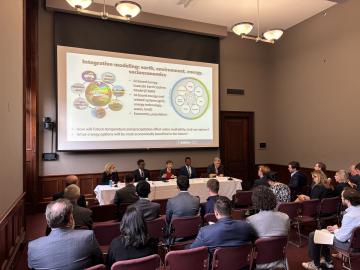
Filter News
Area of Research
- Advanced Manufacturing (2)
- Biology and Environment (22)
- Computational Biology (2)
- Computational Engineering (1)
- Computer Science (2)
- Electricity and Smart Grid (1)
- Energy Science (18)
- Fuel Cycle Science and Technology (1)
- Functional Materials for Energy (1)
- Fusion and Fission (28)
- Fusion Energy (10)
- Isotope Development and Production (1)
- Isotopes (4)
- Materials (22)
- Materials for Computing (1)
- National Security (17)
- Neutron Science (7)
- Nuclear Science and Technology (36)
- Nuclear Systems Modeling, Simulation and Validation (1)
- Sensors and Controls (1)
- Supercomputing (49)
News Topics
- (-) High-Performance Computing (130)
- (-) Nuclear Energy (122)
- (-) Security (31)
- 3-D Printing/Advanced Manufacturing (146)
- Advanced Reactors (40)
- Artificial Intelligence (131)
- Big Data (79)
- Bioenergy (112)
- Biology (128)
- Biomedical (73)
- Biotechnology (39)
- Buildings (74)
- Chemical Sciences (86)
- Clean Water (33)
- Composites (35)
- Computer Science (226)
- Coronavirus (48)
- Critical Materials (29)
- Cybersecurity (35)
- Education (5)
- Element Discovery (1)
- Emergency (4)
- Energy Storage (114)
- Environment (218)
- Exascale Computing (67)
- Fossil Energy (8)
- Frontier (64)
- Fusion (66)
- Grid (74)
- Hydropower (12)
- Irradiation (3)
- Isotopes (62)
- ITER (9)
- Machine Learning (68)
- Materials (157)
- Materials Science (158)
- Mathematics (12)
- Mercury (12)
- Microelectronics (4)
- Microscopy (56)
- Molten Salt (10)
- Nanotechnology (64)
- National Security (86)
- Neutron Science (171)
- Partnerships (68)
- Physics (69)
- Polymers (35)
- Quantum Computing (53)
- Quantum Science (93)
- Simulation (65)
- Software (1)
- Space Exploration (26)
- Statistics (4)
- Summit (71)
- Transportation (103)
Media Contacts

A research team led by the University of Maryland has been nominated for the Association for Computing Machinery’s Gordon Bell Prize. The team is being recognized for developing a scalable, distributed training framework called AxoNN, which leverages GPUs to rapidly train large language models.
Verónica Melesse Vergara and Felipe Polo-Garzon, two staff members at ORNL have been honored with Luminary Awards from Great Minds in STEM, a nonprofit organization dedicated to promoting STEM careers in underserved communities.

A multi-institutional team of researchers led by the King Abdullah University of Science and Technology, or KAUST, Saudi Arabia, has been nominated for the Association for Computing Machinery’s 2024 Gordon Bell Prize for Climate Modelling.

Two papers led by researchers from ORNL received “Editor’s Choice” awards from the journal Future Generation Computer Systems. Both papers explored the possibilities of integrating quantum computing with high performance computing.

Researchers led by the University of Melbourne, Australia, have been nominated for the Association for Computing Machinery’s 2024 Gordon Bell Prize in supercomputing for conducting a quantum molecular dynamics simulation 1,000 times greater in size and speed than any previous simulation of its kind.

The Advanced Plant Phenotyping Laboratory at ORNL utilizes robotics, multi-modal imaging, and AI to enhance understanding of plant genetics and interactions with microbes. It aims to connect genes to traits for advancements in bioenergy, agriculture, and climate resilience. Senior scientist Larry York highlights the lab's capabilities and the insights from a new digital underground imaging system to improve biomass feedstocks for bioenergy and carbon storage.

To bridge the gap between experimental facilities and supercomputers, experts from SLAC National Accelerator Laboratory are teaming up with other DOE national laboratories to build a new data streaming pipeline. The pipeline will allow researchers to send their data to the nation’s leading computing centers for analysis in real time even as their experiments are taking place.

Prasanna Balprakash, director of AI programs for ORNL, discussed advancing climate and weather research through high performance computing and artificial intelligence as part of a September 18 panel for the United States Senate.

U2opia Technology has licensed Situ and Heartbeat, a package of technologies from the Department of Energy’s Oak Ridge National Laboratory that offer a new method for advanced cybersecurity monitoring in real time.

The Summit supercomputer, once the world’s most powerful, is set to be decommissioned by the end of 2024 to make way for the next-generation supercomputer. Over the summer, crews began dismantling Summit’s Alpine storage system, shredding over 40,000 hard drives with the help of ShredPro Secure, a local East Tennessee business. This partnership not only reduced costs and sped up the process but also established a more efficient and secure method for decommissioning large-scale computing systems in the future.


